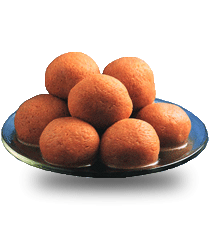Rasgulla
 | |
| Alternative names | Rasogulla |
|---|---|
| Place of origin | India |
| Region or state | Bengal, Orissa |
| Main ingredients | Chhana/Chhena,Sugar |
| Variations | Bikalkar rasagola, Kheermohan |
Rasgulla (Bengali: রসগোল্লা rôshogolla [ˈrɔʃoˌgolːa]; Hindi: रसगुल्ला rasgullā; Odia: ରସଗୋଳା rôsôgola; ) is a syrupy dessert of India, most popular in Bengal and Orissa.
It is made from chhana/chhena and sugar. Sometimes semolina is also added.
Preparation
It is prepared by kneading chhana/chhena (fresh curd cheese) often lightened with a small amount of semolina, and rolling them into small balls. These are then boiled in a light sugar syrup until the syrup permeates the balls.
History
The rasagolla is a very popular cheese based, syrupy sweet dish. Origination of this sweet is often disputed by Bengal and Orissa. However, the Bengali variety of rasagolla looks spongier and white while Oriya variety of rasagolla looks tight and cream-colored. One theory claims that rasagolla was originated in Orissa[1][2][3][4] , then under Bengal Presidency during Ninteenth century. It is supposed to have been a traditional Oriya dish for centuries. Arguably, the best rasagollas in Orissa were made by the Kar brothers, the descendants of a local confectioner, Bikalananda Kar, in the town of Salepur, near Cuttack[5]. Another variant of this dish that is made in the town of Pahala, located between the cities of Bhubaneswar and Cuttack, is also very popular locally[6]. One theory pinpoints the origin of the rasagolla to the town of Puri in coastal Orissa, where it is a traditional offering to the Hindu goddess, Lakshmi, the consort of the Puri temple's main deity, Jagannath. In fact, it is an age-old custom inside the temple to offer rasagollas to Lakshmi in order to appease her wrath for ignoring her, after the commencement of the annual chariot festival (Rath Yatra)[7][8].
The recipe for making rasagollas eventually made its way from Orissa to neighboring West Bengal. This was during the Bengal renaissance when brahmin cooks from Orissa, especially from Puri, were routinely employed in richer Bengali households. They were famed for their culinary skills and commonly referred to as Ude Thakurs (Oriya brahmin-cooks). As a result, many Oriya delicacies got incorporated into the Bengali kitchen[9][10][11]. It is widely believed that in 1868, Nobin Chandra Das of Bagbazar, Kolkata, modified the original recipe to extend the shelf life of the highly perishable sweet and make it marketable. This modification made the rasagolla somewhat spongier and tougher and also, as some maintain, compromised on the dish's taste. Nevertheless, Das earned the sobriquet, "rasagolla's Columbus" within local circles. His son, K. C. Das started canning rasagollas leading to their even wider availability. These became known as the sponge rasagollas. Another Bengali claim credits a certain Haradhan Maira for the recipe's introduction in Bengal in place of Nobin Chandra Das.
Eventually the popularity of rasagollas spread to all other parts of India. Although traditionally sold inside clay pots in Orissa and sometimes in Bengal, sponge rasagollas in cans have become popular nowadays. Such canned rasagollas are available throughout India, Pakistan and Bangladesh, as well as in South Asian grocery stores in Britain and North America. They are marketed not only by K. C. Das and (more recently) the Kar brothers, but also by several other Indian sweet makers from places such as Bikaner and Delhi.
Variations

Rasagollas are usually served at room temperature or colder. However modern Indian households also tend to serve them chilled. The Pahala variant of Orissa is perhaps unusual in being one that is served piping hot[6].
In Bengal, kheermohan refers to a bigger version of rasagolla, whereas in Orissa, where rasagollas are generally larger in size, the words kheermohan and rasagolla are used more interchangeably.
In Orissa, it is not uncommon to embed a single raisin or cashew inside each rasagolla. Elsewhere, a single cardamom seed is embedded to give a fragrant variant. In northern India, the dish also comes flavored in saffron, rosewater, and sometimes garnished with chopped pistachios.
In Orissa and Bengal, a variation of this dish that is made of jaggery is prepared during festive occasions.
Derivatives
Rasagolla is the first syrupy Indian cheese desserts. It is the precursor of many other Oriya and Bengali delicacies, such as chhena jhilli, rasmalai, raskadam, chamcham, pantua, malai chop, and kheersagar. Rasagolla, along with chhena gaja and chhena poda, forms the classic Oriya trinity of chhena desserts. In Bengal, rasagolla and a variety of other chhena sweets such as sondesh, are collectively referred to as Bengali sweets.
Kamalabhog, which mixes orange extract with the chhena, is commonly sold in Bengal. In the dish kheersagar, thick, sweetened milk called rabidi is used instead of sugar syrup. While this dish is largely confined to Orissa, a similar dish rasmalai has become very popular throughout India, mainly due to the efforts of the Kolkata based confectioners K. C. Das, Ganguram and Bhim Nag. In that, the syrup is replaced with sweetened milk of a thinner consistency.
Malai chop, a Kolkata invention, consists of prepared chhena that is sandwiched with a layer of sweet, creamy substance also made of milk. In the Bengali pantua, the chhena balls are deep fried in oil before being soaked in syrup.
See also
External links
- Rasagoola of Pahal, Orissa
- Largest Rasagola market in the world
- Video on how to make Rosogolla
- Orissa: Bhubaneshwar, Puri, Cuttack & Konark - Land Of Gods & Great Food
- Rasgulla Recipe
- Kolkata
- Rasgula at Contact Pakistan
- Munus Shankar, "Indian Sweets and Desserts"
- RasMalai Ras Gulla (Cheese Balls in Sugar Syrup)
- Image of Rasgulla



